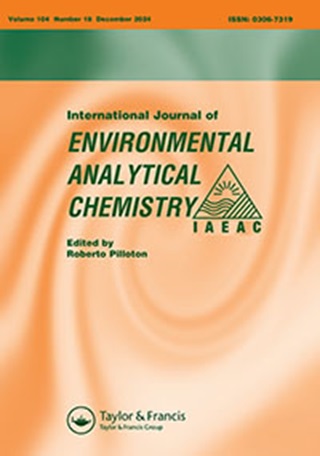金属有机框架光催化剂辅助过氧化物法去除废气中的甲醛和乙醛:中间体和矿化
IF 2.5
4区 化学
Q3 CHEMISTRY, ANALYTICAL
International Journal of Environmental Analytical Chemistry
Pub Date : 2023-09-25
DOI:10.1080/03067319.2023.2260767
引用次数: 0
摘要
摘要甲醛(FA)和乙醛(AA)是工业过程中使用的两种主要污染物。研究了BiOI@NH2-MIL-125 (Ti)@沸石异质结构结合紫外辅助过氧酮工艺在连续废气流中氧化降解醛类的效果。采用XRD、FTIR、FESEM、EDS、EDS元素映射、BET、TEM和XPS等表征方法对催化剂进行了表征。本研究的重点是利用单因素一次(OFAT)技术优化去除FA和AA的参数选择。因此,研究了操作参数:空气流量、臭氧进料速率、过氧化氢(H2O2)浓度、相对湿度(RH)和初始浓度对FA和AA去除效率的影响,并利用OFAT程序进行了优化。结果表明,在空气流速为0.2 L/min, O3投加量分别为0.3和0.4 mg/min, H2O2浓度分别为150和200 ppm,相对湿度为35%,初始污染物浓度为5 ppm的条件下,FA和AA可以完全降解。此外,动力学模型表明,FA和AA降解过程符合一级动力学(R2 = 0.85)。矿化分析表明,在4.3 ppm和3.9 ppm的CO2水平下,FA和AA可以完全降解。总的来说,可以得出结论,建议的处理方法能够有效地从废气中去除感兴趣的醛。致谢特别感谢我的导师Majid Kermani博士提出了这个问题,以及他在整个工作过程中的支持和指导。我也感谢Yousef Abdossalmi Asl博士,他的建议和协助对推动整个项目的完成至关重要。披露声明作者未报告潜在的利益冲突。补充数据本文的补充数据可在https://doi.org/10.1080/03067319.2023.2260767Data网站上获取。可用性声明本研究过程中产生或分析的所有数据均包含在本文中。我们感谢伊朗医学科学大学为本研究提供资金,资助号为:[98-4-2-16909]。本文章由计算机程序翻译,如有差异,请以英文原文为准。
Metal organic framework-based photocatalyst-assisted peroxone process for formaldehyde and acetaldehyde removal from waste air stream: intermediates and mineralization
ABSTRACTFormaldehyde (FA) and acetaldehyde (AA) are known as the two major pollutants used at industrial processes. The BiOI@NH2-MIL-125 (Ti)@Zeolite heterostructures combined with UV-assisted peroxone process were investigated for oxidative degradation of the aldehydes in a continuous waste air stream. Different characterisation methods including XRD, FTIR, FESEM, EDS, EDS elemental mapping, BET, TEM and XPS were used to characterise the photocatalyst. This study focuses on optimising the parameters selected for removal of FA and AA using the one-factor-at-a-time (OFAT) technique. Therefore, the effects of operational parameters: air flow rate, ozone feeding rate, hydrogen peroxide (H2O2) concentration, relative humidity (RH), and initial concentrations on FA and AA removal efficiency were investigated and optimised using the OFAT procedure. The results showed the complete degradation of FA and AA were achieved at optimal conditions (air flow rate: 0.2 L/min, O3 dosage: 0.3 and 0.4 mg/min for FA and AA, respectively, H2O2 concentration: 150 and 200 ppm for FA and AA, respectively, RH of 35%, and an initial pollutant concentration of 5 ppm). In addition, kinetic models revealed that the FA and AA degradation process are fitted with first-order kinetic (R2 = 0.85). Mineralisation analysis revealed that the complete degradation of FA and AA were obtained at CO2 levels of 4.3 and 3.9 ppm, respectively. Overall, it could be concluded that the suggested treatment method has the capability to efficiently eliminate the aldehydes of interest from waste gases.KEYWORDS: Formaldehydeacetaldehydephotoperoxonemetal-organic frameworkswaste airDNPH AcknowledgmentsSpecial thanks goes to my supervisor Dr. Majid Kermani for raising the issue as well as his support and guidance throughout this work. I also appreciate Dr. Yousef Abdossalmi Asl whose advice and assistance were crucial to drive entire the project to completion.Disclosure statementNo potential conflict of interest was reported by the author(s).Ethical ApprovalIR.IUMS.REC.1398.1175Supplementary dataSupplemental data for this article can be accessed online at https://doi.org/10.1080/03067319.2023.2260767Data availability statementAll data generated or analysed during this study are included in this article.Additional informationFundingWe acknowledge Iran University of Medical Sciences, for funding this research under grant No. [98-4-2-16909].
求助全文
通过发布文献求助,成功后即可免费获取论文全文。
去求助
来源期刊
CiteScore
5.90
自引率
7.70%
发文量
373
审稿时长
4.4 months
期刊介绍:
International Journal of Environmental Analytical Chemistry comprises original research on all aspects of analytical work related to environmental problems. This includes analysis of organic, inorganic and radioactive pollutants in air, water, sediments and biota; and determination of harmful substances, including analytical methods for the investigation of chemical or metabolic breakdown patterns in the environment and in biological samples.
The journal also covers the development of new analytical methods or improvement of existing ones useful for the control and investigation of pollutants or trace amounts of naturally occurring active chemicals in all environmental compartments. Development, modification and automation of instruments and techniques with potential in environment sciences are also part of the journal.
Case studies are also considered, particularly for areas where information is scarce or lacking, providing that reported data is significant and representative, either spatially or temporally, and quality assured. Owing to the interdisciplinary nature of this journal, it will also include topics of interest to researchers in the fields of medical science (health sciences), toxicology, forensic sciences, oceanography, food sciences, biological sciences and other fields that, in one way or another, contribute to the knowledge of our environment and have to make use of analytical chemistry for this purpose.

 求助内容:
求助内容: 应助结果提醒方式:
应助结果提醒方式:


